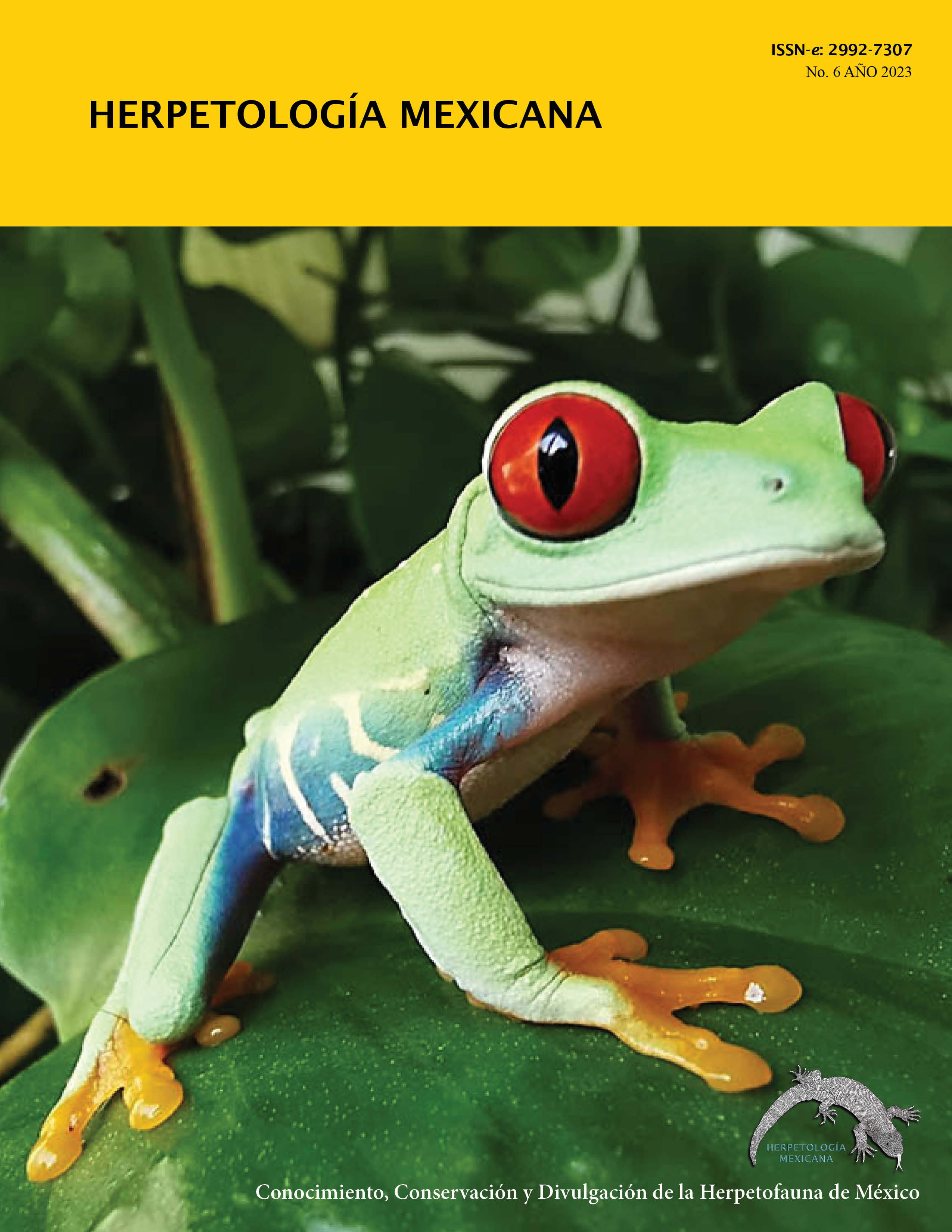Agalychnis callidryas: problemas y soluciones para su cría en cautiverio
DOI:
https://doi.org/10.69905/05r0rq95Palabras clave:
Rana ojos rojos, Hylidae, Crianza, Reproducción, CautiverioResumen
Las ranas del género Agalychnis y particularmente A. callidryas, con distribución en México, son extensamente saqueadas para el comercio de mascotas, una de sus principales amenazas. En este sentido, la reproducción en cautiverio de anfibios es una alternativa viable para la conservación pese a que no es fácil en especies con las características de esta rana. En el presente trabajo se describen algunas complicaciones que surgen durante la reproducción en cautiverio de A. callidryas y sus posibles soluciones, y se muestran tratamientos que permitieron la solución de estos problemas: infecciones bacterianas, helmínticas y para desgarres en la piel. Se incluye, además, el uso de sus patrones corporales para la identificación de individuos. El objetivo es proporcionar alternativas que puedan ser utilizadas en zoológicos, acuarios y otros centros reproductivos, así como en programas de reproducción para la conservación de anuros amenazados similares a esta especie.
Referencias
Aevarsson, U., A. Graves, K. Carter, T. Doherty-Bone, D. Kane, F. Servini, B. Tapley & C. Michaels. 2022. Individual identification of the Lake Oku clawed frog (Xenopus longipes) using a photographic identification technique. Herpetological Conservation and Biology, 17: 67-75.
Andrzejaczek, S., J. Meeuwig, D. Rowat, S. Pierce, T. Davies, R. Fisher & M. Meekan. 2016. The ecological connectivity of whale shark aggregations in the Indian Ocean: a photo-identification approach. Royal Society Open Science, 3 (11): 160455. http://dx.doi.org/10.1098/rsos.160455
Bardier, C., D. Székely, G. Augusto-Alves, N. Matínez-Latorraca, B. R. Schmidt & S. S. Cruickshank. 2020. Performance of visual vs. software-assisted photo-identification in mark-recapture studies: a case study examining different life stages of the pacific horned frog (Ceratophrys stolzmanni). Amphibia-Reptilia, 42 (1): 17-28.
Bolochio, B. E., J. N. Lescano, J. M. Cordier, R. Loyola & J. Nori. 2020. A functional perspective for global amphibian conservation. Biological Conservation, 245 (2020) 108572: 1-9.
Bradfield, K. S. 2004: Photographic identification of individual Archey’s frogs, Leiopelma archeyi, from natural markings. DOC Science Internal Series 191. Department of Conservation,Wellington, 36 pp.
Betül, G., S. Tamer, G. Sonnur & N. Mehmet. 2009. Emergency wounds treated with cyanoacrylate and long-term results in pediatrics: a series of cases; what are the advantages and boards? BMC Research Notes, 2 (1): 132-132. https://doi.org/10.1186/1756-0500-2-132
Campião, K. M., D. H. Morais, O. T. Dias, A. Aguilar, G. Toledo, I. Tavares & R. J. da Silva. 2014. Checklist of helminth parasites of amphibians from South America. Zootaxa, 3843 (1): 001-093. CITES (database). 2023. Agalychnis callidryas imports and exports. https://trade.cites.org [Acceso: marzo, 2023]
Clayton, L., J. Nelson, M. Payton, J. McDonnell, B. Rossi, K. King-Rahn & D. Woodburn. 2012. Clinical Signs, Management, and Outcome of Presumptive Ivermectin Overdose in a Group of Dendrobatid Frogs. Journal of Herpetological Medicine and Surgery, 22: 5-11.
Crump, A. 2017. Ivermectin: enigmatic multifaceted “wonder” drug continues to surprise and exceed expectations. The Journal of Antibiotics, 70 (5): 495-505. https://doi.org/10.1038/ja.2017.11
Frisch A.J., & J-P. A. Hobbs. 2007. Photographic identification based on unique, polymorphic colour patterns: a novel method for tracking a marine crustacean. Journal of Experimental Marine Biology and Ecology, 351: 294-299.
Frost, D. R. 2023. Amphibian Species of the World: An Online Reference. Version 6.2. https://amphibiansoftheworld.amnh.org/ doi.org/10.5531/db.vz.0001 [acceso: septiembre, 2023].
Hayes, T. B., P. Falso, S. Gallipeau & M. Stice. 2010. The cause of global amphibian declines: a developmental endocrinologist’s perspective. The Journal of Experimental Biology, 213 (6): 921-933. https://doi.org/10.1242/jeb.040865
IUCN SSC Amphibian Specialist Group. 2020. Agalychnis callidryas. The IUCN Red List of Threatened Species 2020: e.T55290A3028059. https://dx.doi.org/10.2305/IUCN.UK.2020-1.RLTS.T55290A3028059.en. [Acceso: marzo, 2023]
Kenyon, N., A. Phillott & R. Alford. 2010. Temporal variation in dorsal patterns of juvenile green-eyed tree frogs, Litoria genimaculata (Anura: Hylidae). Herpetological Conservation and Biology, 5: 126-131.
Kühl, H. S. & T. Burghardt. 2013. Animal biometrics: quantifying and detecting phenotypic appearance. Trends in Ecology & Evolution, 28 (7): 432-441.
Lee, D. E., D. R. Cavener & M. L. Bond. 2018. Seeing spots: quantifying mother-offspring similarity and assessing fitness consequences of coat pattern traits in a wild population of giraffes (Giraffa camelopardalis). PeerJ, 6, e5690.
Lee, J. C. 2000. A field guide to the amphibians and reptiles of the maya world. Cornell University Press, Ithaca, USA, 416 pp.
Lisboa, C. & R. Vaz. 2021. Captive breeding program for Scinax alcatraz (Anura:Hylidae): introducing amphibian ex situ conservation in Brazil. Amphibian and Reptile Conservation. 14.
Muijsers M., A. Martel, V. R. Pascale, K. Baert, G. Vercauteren, R. Ducatelle, D. B. Patrick, F. Vercammen, F. Haesebrouck & F. Pasmans. 2012. Antibacterial therapeutics for the treatment of chytrid infection in amphibians: Columbus’s egg? BMC Veterinary Research, 8 (175): 1-7. https://doi.org/10.1186/1746-6148-8-175
Méndez-Ramírez, I., D. L. Namihira-Guerrero, A. Moreno & C. Sosa de Martínez. 2004. El Protocolo de Investigación. Trillas. México.
Miles, E. M. 1950. Red-Leg in Tree-frogs caused by bacterium alkaligenes. Journal of General Microbiology, 4 (3): 434-436.
McCranie, J. R., J. Sunyer & J. G. Martínez-Fonseca. 2019. Comments and updates to “Guía Ilustrada de Anfibios y Reptiles de Nicaragua” along with taxonomic and related suggestions associated with the herpetofauna of Nicaragua. Revista Nicaraguense de Biodiversidad, 52: 8-9.
Nichols, D. K., E. W. Lamirande, A. Pessier & J. Longcore. 2001. Experimental transmission of cutaneous chytridiomycosis in dendrobatid frogs. Journal of Wildlife Diseases, 37 (1): 1-11. https://doi.org/10.7589/0090-3558-37.1.1
Nguyen, Q. T. & M. P. Tran. 2021. Drugs and chemicals use in frog farming in Dong Thap province. Can Tho University Journal of Science, 13 (Aquaculture), 73-78.
Otsuka-Yamaguchi, R., A. Kawasumi-Kita, N. Kudo, Y. Izutsu, K. Tamura & H. Yokoyama. 2017. Cells from subcutaneous tissues contribute to scarless skin regeneration in Xenopus laevis froglets. Developmental Dynamics, 246 (8): 585-597.
Panayotova-Pencheva, M. S. 2016. Experience in the Ivermectin Treatment of Internal Parasites in Zoo and Captive Wild Animals: A Review. Der Zoologische Garten, 85 (5): 280-308.
Patel, N. G. & A. Das. 2020. Shot the spots: A reliable field method for individual identification of Amolops formosus (Anura, Ranidae). Herpetozoa, 33: 7-15.
Poll, C. P. 2009. Wound management in amphibians: etiology and treatment of cutaneous lesions. Journal of Exotic Pet Medicine, 18 (1): 20-35.
Poole, V. 2008. Guia para el manejo de anfibios en cautiverio. National Aquarium in Baltimore Shelly Grow, Association of Zoos and Aquariums Edición 1.1, San Diego, California, USA. https://assets.speakcdn.com/assets/2332/manualespanol.pdf
Pyburn, W. F. 1970. Breeding Behavior of the Leaf-Frogs Phyllomedusa callidryas and Phyllomedusa dacnicolor in Mexico. Copeia, 1970 (2): 209-218. https://doi.org/10.2307/1441643
Rivera-Correa, M., F. Duarte-Cubides, J. V. Rueda-Almonacid & J. M. Daza-R. 2013. A new red-eyed treefrog of Agalychnis (Anura: Hylidae: Phyllomedusinae) from middle Magdalena River valley of Colombia with comments on its phylogenetic position. Zootaxa, 3636: 85-100.
Robertson, J. M. & A. D. Robertson. 2008. Spatial and temporal patterns of phenotypic variation in a Neotropical frog. Journal of Biogeography, 35 (5): 830-843.
Robertson, J. M. & H. W. Greene. 2017. Bright colour patterns as social signals in nocturnal frogs. Biological Journal of the Linnean Society, 121 (4): 849-857.
Rosa, G., & A. Fernández-Loras. 2012. Emergency procedures in the field: a report of wound treatment and fast healing in the giant ditch frog (Leptodactylus fallax). Animal Welfare, 21 (4): 559-562.
Safrin, S., B. L. Lee & M. A. Sande. 1994. Adjunctive folinic acid with trimethoprim-sulfamethoxazole for Pneumocystis carinii pneumonia in aids patients is associated with an increased risk of therapeutic failure and death. The Journal of Infectious Diseases, 170 (4): 912-917. https://doi.org/10.1093/infdis/170.4.912
Savage, J. 2002. The Amphibians and Reptiles of Costa Rica: A Herpetofauna Between Two Continents, Between Two Seas. Bibliovault OAI Repository, the University of Chicago Press, 954 pp.
SEMARNAT. 2019. Proyecto de Modificación del Anexo Normativo III, Lista de especies en riesgo de la Norma Oficial Mexicana NOM-059-SEMARNAT-2010, Diario Oficial de la Federación, 14 de noviembre de 2019.
Schad, K. (Ed.) 2007. Amphibian Population Management Guidelines. Amphibian Ark Amphibian Population Management Workshop; December 10-11, 2007; San Diego, CA, USA. Amphibian Ark, 31 pp. www.amphibianark.org
Smith, S. A. 2007. Compendium of drugs and compounds used in amphibians. ILAR Journal, 48 (3): 297-300. https://doi.org/10.1093/ilar.48.3.297
Yokoyama, H., T. Maruoka, A. Aruga, T. Amano, S. Ohgo, T. Shiroishi & K. Tamura. 2011. Prx-1 expression in Xenopus laevis scarless skin-wound healing and its resemblance to epimorphic regeneration. Journal of Investigative Dermatology, 131 (12):2477-85. DOI: 10.1038/jid.2011.223
Wilson L. D., J. D. Johnson & V. Mata-Silva. 2013. A conservation reassessment of the amphibians of Mexico based on the EVS measure. Amphibian & Reptile Conservation, 7 (1): 97-127.
Zippel, K., K. Johnson, R. Gagliardo, R. Gibson, M. McFadden, R. Browne, C. Martinez & E. Townsend. 2011. The Amphibian Ark: a global community for ex situ conservation of amphibians. Herpetological Conservation and Biology, 6: 340-352.
Publicado
Número
Sección
Licencia
Derechos de autor 2023 Fabián Vergara-Ovalle (Autor/a)

Esta obra está bajo una licencia internacional Creative Commons Atribución-NoComercial-SinDerivadas 4.0.






